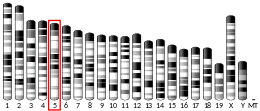HPS4
Hermansky–Pudlak syndrome 4 protein is a protein that in humans is encoded by the HPS4 gene.[5][6][7]
Hermansky–Pudlak syndrome is a disorder of organelle biogenesis in which oculocutaneous albinism, bleeding, and pulmonary fibrosis result from defects of melanosomes, platelet dense granules, and lysosomes. Mutations in this gene as well as several others can cause this syndrome. The protein encoded by this gene appears to be important in organelle biogenesis and is similar to the mouse 'light ear' protein. Five transcript variants encoding different isoforms have been found for this gene. In addition, transcript variants utilizing alternative polyadenylation signals exist.[7]
In melanocytic cells HPS4 gene expression may be regulated by MITF.[8]
References
- GRCh38: Ensembl release 89: ENSG00000100099 - Ensembl, May 2017
- GRCm38: Ensembl release 89: ENSMUSG00000042328 - Ensembl, May 2017
- "Human PubMed Reference:". National Center for Biotechnology Information, U.S. National Library of Medicine.
- "Mouse PubMed Reference:". National Center for Biotechnology Information, U.S. National Library of Medicine.
- Suzuki T, Li W, Zhang Q, Karim A, Novak EK, Sviderskaya EV, Hill SP, Bennett DC, Levin AV, Nieuwenhuis HK, Fong CT, Castellan C, Miterski B, Swank RT, Spritz RA (Mar 2002). "Hermansky–Pudlak syndrome is caused by mutations in HPS4, the human homolog of the mouse light-ear gene". Nat Genet. 30 (3): 321–4. doi:10.1038/ng835. PMID 11836498.
- Chiang PW, Oiso N, Gautam R, Suzuki T, Swank RT, Spritz RA (May 2003). "The Hermansky–Pudlak syndrome 1 (HPS1) and HPS4 proteins are components of two complexes, BLOC-3 and BLOC-4, involved in the biogenesis of lysosome-related organelles". J Biol Chem. 278 (22): 20332–7. doi:10.1074/jbc.M300090200. PMID 12663659.
- "Entrez Gene: HPS4 Hermansky–Pudlak syndrome 4".
- Hoek KS, Schlegel NC, Eichhoff OM, et al. (2008). "Novel MITF targets identified using a two-step DNA microarray strategy". Pigment Cell Melanoma Res. 21 (6): 665–76. doi:10.1111/j.1755-148X.2008.00505.x. PMID 19067971.
External links
Further reading
- Bonaldo MF, Lennon G, Soares MB (1997). "Normalization and subtraction: two approaches to facilitate gene discovery". Genome Res. 6 (9): 791–806. doi:10.1101/gr.6.9.791. PMID 8889548.
- Dunham I, Shimizu N, Roe BA, et al. (1999). "The DNA sequence of human chromosome 22". Nature. 402 (6761): 489–95. doi:10.1038/990031. PMID 10591208.
- Hirosawa M, Nagase T, Murahashi Y, et al. (2001). "Identification of novel transcribed sequences on human chromosome 22 by expressed sequence tag mapping". DNA Res. 8 (1): 1–9. doi:10.1093/dnares/8.1.1. PMID 11258795.
- Strausberg RL, Feingold EA, Grouse LH, et al. (2003). "Generation and initial analysis of more than 15,000 full-length human and mouse cDNA sequences". Proc. Natl. Acad. Sci. U.S.A. 99 (26): 16899–903. doi:10.1073/pnas.242603899. PMC 139241. PMID 12477932.
- Collins JE, Goward ME, Cole CG, et al. (2003). "Reevaluating human gene annotation: a second-generation analysis of chromosome 22". Genome Res. 13 (1): 27–36. doi:10.1101/gr.695703. PMC 430954. PMID 12529303.
- Anderson PD, Huizing M, Claassen DA, et al. (2003). "Hermansky–Pudlak syndrome type 4 (HPS-4): clinical and molecular characteristics". Hum. Genet. 113 (1): 10–7. doi:10.1007/s00439-003-0933-5. PMID 12664304.
- Martina JA, Moriyama K, Bonifacino JS (2003). "BLOC-3, a protein complex containing the Hermansky–Pudlak syndrome gene products HPS1 and HPS4". J. Biol. Chem. 278 (31): 29376–84. doi:10.1074/jbc.M301294200. PMID 12756248.
- Nazarian R, Falcón-Pérez JM, Dell'Angelica EC (2003). "Biogenesis of lysosome-related organelles complex 3 (BLOC-3): a complex containing the Hermansky–Pudlak syndrome (HPS) proteins HPS1 and HPS4". Proc. Natl. Acad. Sci. U.S.A. 100 (15): 8770–5. doi:10.1073/pnas.1532040100. PMC 166388. PMID 12847290.
- Ota T, Suzuki Y, Nishikawa T, et al. (2004). "Complete sequencing and characterization of 21,243 full-length human cDNAs". Nat. Genet. 36 (1): 40–5. doi:10.1038/ng1285. PMID 14702039.
- Collins JE, Wright CL, Edwards CA, et al. (2005). "A genome annotation-driven approach to cloning the human ORFeome". Genome Biol. 5 (10): R84. doi:10.1186/gb-2004-5-10-r84. PMC 545604. PMID 15461802.
- Gerhard DS, Wagner L, Feingold EA, et al. (2004). "The status, quality, and expansion of the NIH full-length cDNA project: the Mammalian Gene Collection (MGC)". Genome Res. 14 (10B): 2121–7. doi:10.1101/gr.2596504. PMC 528928. PMID 15489334.
- Huizing M, Parkes JM, Helip-Wooley A, et al. (2007). "Platelet alpha granules in BLOC-2 and BLOC-3 subtypes of Hermansky–Pudlak syndrome" (PDF). Platelets. 18 (2): 150–7. doi:10.1080/13576500600936039. PMID 17365864.





